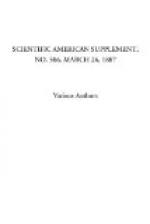If the copper has not been removed, it will deposit on the anodes when the bath is at rest. It should then be removed by scouring.
Copper produces a reddish tinge, which is by no means unpleasant compared with the dazzling whiteness of the nickel deposit. If this is desired, it is far better to use a separate bath, using anodes of suitable composition.
The want of adhesion between the deposited coating and the article need not be feared if cleanliness be attended to and the article, while in the bath, be not touched by the hands.
The bath should be neutral, or nearly so, slightly acid rather than alkaline. It is obvious that, as such a liquid has no detergent action on a soiled surface, scrupulous care must be taken in scouring and rinsing. Boiling alkaline solutions and a free use of powdered pumice and the scrubbing brush must on no account be neglected.
A few words on the construction of the tanks. A stout wood box, which need not be water-tight, is lined with sheet lead, the joints being blown, not soldered. An inner casing of wood which projects a few inches above the lead lining is necessary in order to avoid any chance of “short circuiting” or damage to the lead from the accidental falling of anodes or any article which might cut the lead. It is by no means a necessity that the lining should be such as to prevent the liquid getting to the lead.
On a future occasion I hope to supplement this paper with the analysis of the double sulphates used, and an account of the behavior of electrolytically prepared crucibles and dishes as compared with those now in the market.—Chem. News.
* * * * *
CHILLED CAST IRON.
At a recent meeting of the engineering section of the Bristol Naturalists’ Society a paper on “Chilled Iron” was read by Mr. Morgans, of which we give an abstract. Among the descriptions of chilled castings in common use the author instanced the following: Sheet, corn milling, and sugar rolls; tilt hammer anvils and bits, plowshares, “brasses” and bushes, cart-wheel boxes, serrated cones and cups for grinding mills, railway and tramway wheels and crossings, artillery shot and bolts, stone-breaker jaws, circular cutters, etc. Mr. Morgans then spoke of the high reputation of sheet mill rolls and wheel axle boxes made in Bristol. Of the latter in combination with wrought iron wheels and steeled axles, the local wagon works company are exporting large numbers. With respect to the strength and fatigue resistance of chilled castings, details were given of some impact tests made in July, 1864, at Pontypool, in the presence of Captain Palliser, upon some of his chilled bolts, 123/4 in. long by 4 in. diameter, made from Pontypool cold-blast pig iron. Those made from No. 1 pig iron—the most graphitic and costly—broke more easily than those from No. 2, and so on until those made




